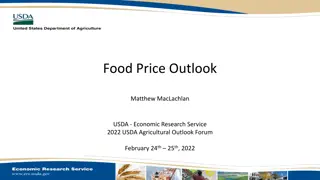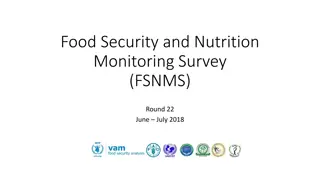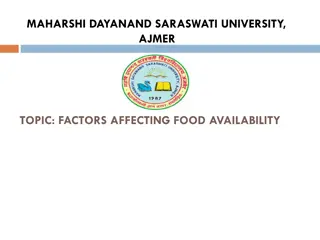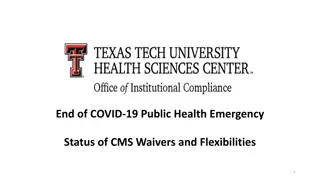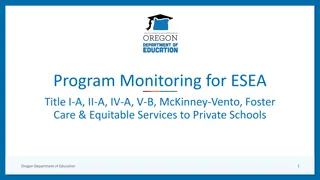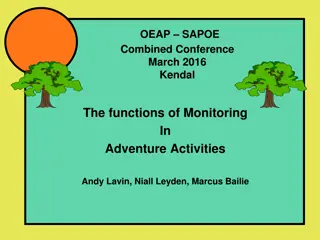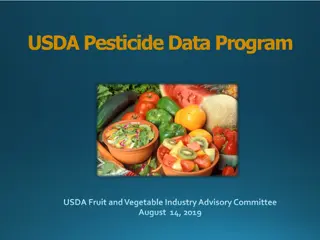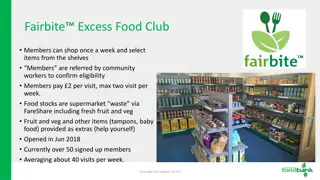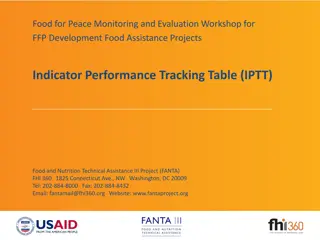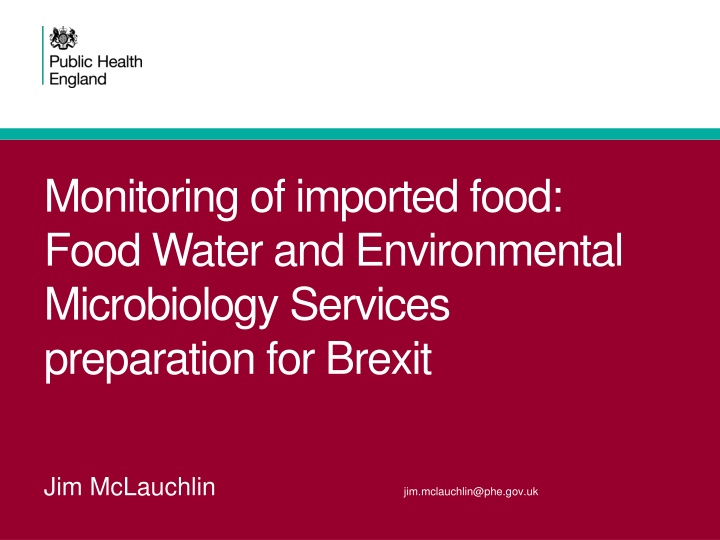
Food Microbiology Services for Brexit Preparation
This content discusses the importance of monitoring imported food, water, and environmental microbiology services in preparation for Brexit. It covers expert advice, laboratory services, surveillance data, early recognition of hazards like Salmonella, and training programs. The data presented includes the detection of Salmonella in imported chicken, the number of samples and consignments affected, and the different serovars of Salmonella detected. The information aims to support the actions of Public Health England (PHE) and other relevant stakeholders in ensuring food safety amidst emerging hazards.
Download Presentation

Please find below an Image/Link to download the presentation.
The content on the website is provided AS IS for your information and personal use only. It may not be sold, licensed, or shared on other websites without obtaining consent from the author. If you encounter any issues during the download, it is possible that the publisher has removed the file from their server.
You are allowed to download the files provided on this website for personal or commercial use, subject to the condition that they are used lawfully. All files are the property of their respective owners.
The content on the website is provided AS IS for your information and personal use only. It may not be sold, licensed, or shared on other websites without obtaining consent from the author.
E N D
Presentation Transcript
Monitoring of imported food: Food Water and Environmental Microbiology Services preparation for Brexit Jim McLauchlin jim.mclauchlin@phe.gov.uk
FW&E Microbiology Services Expert advice and access to laboratory services for food, dairy, environmental and water microbiology National microbiological survey and surveillance data Early recognition, notification, investigation and control of unusual events and outbreaks Evidence base to inform the actions of PHE and others Training of staff in the PHE and external partners Applied R&D to support and progress all of the above 2 APHA Training Day: FW&E Preparations for Brexit
Emerging or changing hazards: Salmonella monitoring in imported chicken Number of samples Number of consignments 2013 2014 2015 2016 2017 2018 Cooked Marinated Salted Raw NK Total Salmonella not detected in any cooked product 32 29 31 50 261 64 2,268 2 0 1 11 2 0 80 23 53 29 47 383 0 2,591 14 9 7 13 101 92 1,165 10 2 2 8 0 0 180 81 93 70 129 747 156 6,284 3 APHA Training Day: FW&E Preparations for Brexit
Salmonella in imported chicken Salmonella detected in 106 (8%) of the 1276 consignments Number of consignments (Salmonella Detected) Year 2013 2014 2015 2016 2017 2018 48(1) 47 (2) 14 (0) 28 (1) 667 (61) 127 (6) Brazil 24 (0) 27 (5) 48 (5) 96 (6) 131 (16) 25 (0) Thailand 9 (0) 18 (0) 4 (0) 17 (1) 2 4 (1) 3 Other 9 (1) 1 1Israel, 2not stated, 3Chile 4 APHA Training Day: FW&E Preparations for Brexit
Serovars of Salmonella detected Number of samples Thailand 49 6 8 1 3 12 1 Brazil 174 5 Chile 6 Israel NS 10 Total Salmonella Agona Salmonella Albany Salmonella Binza Salmonella Braenderup Salmonella Enteritidis Salmonella Give Salmonella Heidelberg Salmonella Hvittingfoss Salmonella Kedougou Salmonella Infantis Salmonella Mbandaka Salmonella Minnesota Salmonella Poona Salmonella Typhimurium Salmonella Virchow Salmonella Weltevreden 1 1 3 2 1 1 139 1 5 1 6 4 1 1 2 4 1 2 1 23 5 FW&E Preparations for Brexit
Whole genome sequencing SNP typing Results from 268 isolates, 220 with SNP addresses Three <5 SNP clusters with human cases were detected: Salmonella Enteritidis, chicken from Thailand, 1 cases in 2016 associated with travel to Thailand Salmonella Infantis from Chile, 1 cases in 2017, no travel history Salmonella Virchow from Thailand, 3 cases in 2016, 2017, and 2018, 2 with travel to Thailand, one no travel history Other associations between isolates from food and clinical cases detected at the 10, 25 and 50 SNP levels some of which were country specific. For example: 2 Salmonella Enteritidis clusters at 10 SNPs from chicken imported from Thailand all of which clustered with patient isolates at 10 SNPs with a travel history of returning from Thailand. 6
Core genome analysis of Salmonella serovars from imported chicken (EnteroBase World database) Human cases UK, Australia Canada Food Salmonella Agona (Thailand) Fish (Thailand) Chicken (USA) UK Salmonella Albany (Thailand) UK, USA, Ireland, Australia Salmonella Enteritidis (Thailand) Chicken (Germany, Netherlands, Brazil) Chicken (Peru) UK Salmonella Heidelberg (Brazil) Salmonella Infantis (Chiie) Salmonella Minnesota (Brazil) UK, USA, Peru UK Ireland Chicken (USA) Fish (China, S Korea, Vietnam) Invertebrate (Thailand) Salmonella Typhimurium (Thailand) Salmonella Weltevreden (Thailand) 7 Work of FW&E Microbiology Services
Betel leaves Betel (paan/pan) leaves (Piper betle L.) traditional product that certain South-eastern Asian populations chew after meals Imported into the EU particularly to UK and Germany but also to Italy, France, The Netherlands and Portugal 8 APHA Training Day: FW&E Preparations for Brexit
9 APHA Training Day: FW&E Preparations for Brexit
QMRA: Salmonella spp. contamination of betel leaves collected at Border Inspection Posts in four English airports Year Collected at Border Inspection Posts Samples collected at Number of samples Number of consignments retail, wholesale or catering Total Salmonella spp. detected (%) Total Salmonella Total Salmonella spp. spp. detected (%) 198 (37%) 120 (23%) 78 (16%) 16 (11%) 24 (21%) 19 (24%) 0 455 (24%) detected (%) 83 (77%) 62 (60%) 42 (43%) 8 (33%) 9 (47%) 10 (77%) 0 214 (57%) 539 515 481 145 116 78 16 1890 108 103 97 24 19 21 6 378 67 0 11 42 22 1 77 220 17 (25%) . 1 (9%) 1 (2%) 3 (14%) 0 11 (14%) 33 (15%) 2011 2012 2013 2014 2015 2016 2017 Total 10 Modelling risk of salmonellosis from betel leaves
Actions by Risk Managers 2011 after initial isolation of S.Augustenborg, FSA informed who issued RASFFs, discussions held between the EU Commission and the Bangladeshi and Indian High Commissions to ascertain what is being done to reduce contamination in the country of origin 2014 EU Commission implemented a temporary suspension of imported betel leaves originating or consigned by Bangladesh (Decision 2014/88/EU) which was extended in June 2015 (Commission Implementing Decision 2014/510/EU) and then to June 2018 and then to June 2020 (Commission Implementing Decision 2018/935). 2014 Betel leaves from India and Thailand were subjected to an increased level of official control at the designated point of (Commission Implementing Regulation (EU) 323/2014) and this continued for India in September 2015 (Commission Implementing Regulation (EU) 2015/1607). 2016 control of betel leaves from India was extended requiring that consignments be accompanied by results of sampling and analysis by the competent authorities in India for the absence of Salmonella (Commission Implementing Regulation (EU) 2016/166). 11 APHA Training Day: FW&E Preparations for Brexit
Actions by Risk Managers Rapid Alert System for Food and Feed (RASFF) 2011-2017 More than 180 notifications 96% were from the UK 12 12 Modelling risk of salmonellosis from betel leaves APHA Training Day: FW&E Preparations for Brexit
EU import prohibition for products from Bangladesh, but 2017, 11 (14%) out of 77 sampled on retail sale were from Bangladesh, Salmonella detected in 4 (36%) Bangladesh betel leaves on sale in London April 2018 13 13 Modelling risk of salmonellosis from betel leaves APHA Training Day: FW&E Preparations for Brexit
Detection of Salmonella in replicate samples taken from consignments Number of 25g samples where Salmonella detected No. of samples per consignment 1 2 3 4 5 10 14 15 28 0 1 1 1 1 1 2 3 4 5 6 13 Total 11 6 7 7 335 7 1 1 1 10 2 6 5 139 2 0 0 0 3 0 1 0 0 0 85 2 0 0 0 53 2 0 0 0 30 0 0 1 0 18 0 1 0 0 10 0 0 0 0 1 0 0 0 0 1 14 APHA Training Day: FW&E Preparations for Brexit
Using an MPN the estimated probability of a betel leaf having at least one Salmonella by quarter and country of origin 15 15 Salmonella NGS at PHE APHA Training Day: FW&E Preparations for Brexit
-Poisson dose response model Will you get infected! Quantitative data on contamination of betel leaves used Estimation used probability of contamination at retail 16 16 Modelling risk of salmonellosis from betel leaves APHA Training Day: FW&E Preparations for Brexit
Estimated probability of illness to an individual by quarter and country using the dose response model 0.00060 0.00050 0.00040 Probability 0.00030 Q1 Q2 Q3 Q4 0.00020 0.00010 0.00000 17 17 Modelling risk of salmonellosis from betel leaves APHA Training Day: FW&E Preparations for Brexit
Using betel leaves from India The probability of acquiring infection following a single exposure (serving comprised a single leaf) varied between: quarter 1; 0.00003 (range 0.00002 to 0.00004) quarter 3; 0.0001 (range 0.00007 to 0.00012) 18 18 Modelling risk of salmonellosis from betel leaves APHA Training Day: FW&E Preparations for Brexit
Population estimate of number of infections No direct consumption data available Not possible to obtain quantitative import data However import data may be problematic since: Not all betel leaves eaten also used for rituals and decoration Clandestine importation occurs 19 19 Modelling risk of salmonellosis from betel leaves APHA Training Day: FW&E Preparations for Brexit
Assessment of the population risk Assumptions consumption only occurred in individuals over 30 years of age men more likely to consume betel leaves than women serving constituted eating a single leaf Two scenarios were modelled: scenario 1, two servings per year for men and one per year for women; scenario 2, 12 servings per year for men and six per year for women. 20 20 Modelling risk of salmonellosis from betel leaves Work of FW&E Microbiology Services
ONS Population data British Asian Indian, Pakistani and Bangladeshi over 30 years of age in England in 2011 718,509 men 696,644 women scenario 1, two servings per year for men and one per year for women 2.1 million servings per year scenario 2, 12 servings per year for men and six per year for women 12.8 million servings per year 21 21 Modelling risk of salmonellosis from betel leaves APHA Training Day: FW&E Preparations for Brexit
Population estimate of infection scenario 1: 2.1 million servings per year 160 cases per year (range 102 to 242) 34 cases per year (range 22 to 51) reported to national surveillance scenario 2: 12.8 million servings per year 960 cases per year (range 612 to 1456) 204 cases per year (range 130 to 310) reported to national surveillance 22 22 Modelling risk of salmonellosis from betel leaves APHA Training Day: FW&E Preparations for Brexit
Two sporadic human cases Patient 1. 74 year-old female of Asian origin S.Bareilly (ST 203) isolated from the faeces in August 2015 S.Bareilly (ST 203) matched at the 0-SNP level to an isolate from betel leaves , country of origin not known Sampled in June 2015 from a retail establishment from the same region <18 miles from patient s home address Patient 2. 44 year old male of East Asian origin S.Newport (ST 31) isolated from the faeces in October 2017 S.Newport (ST 31) matched at the <5-SNP level to an isolate from betel leaves from Bangladesh Betel leaves collected from retail sale in July 2017 from a different region to the patient s home address 23 23 Modelling risk of salmonellosis from betel leaves APHA Training Day: FW&E Preparations for Brexit
Characterisation Salmonella from Border Inspection Posts Where multiple cultures from the same sample or consignment were characterised, only one representative isolate per serovar per consignment has been included 332 representative isolates 46 S.enterica subspecies I serovars identified, plus un-named, Salmonella di arizonae,Salmonella salamae 17% Salmonella Virchow 10% Salmonella Java 8% Salmonella enterica (un-named) 7% Salmonella Brunei 7% Salmonella Litchfield 6% Salmonella Newport 24 24 Modelling risk of salmonellosis from betel leaves Work of FW&E Microbiology Services
Salmonella diversity within a consignment 214 consignments where Salmonella was detected in at least one of the replicate samples between one and 13 cultures submitted for characterisation per consignment. 119 consignments, 2 or more cultures were submitted, 24 (21%) consignments the same serovar was identified on more than one occasion, 95 (79%) consignments, between 2 and 8 different serovars (or species) were identified Amongst all 214 contaminated consignments, at least 95 (44%) had two or more Salmonella serovars (or species) present 25 25 Modelling risk of salmonellosis from betel leaves
Diversity within Salmonella serovars: S. Bareilly Country Setting Retail 2017 MLST 909 203 203 203 203 203 909 SNP not SNP'd 1.1.2.2.2.2.2 1.1.2.2.2.2.2 1.1.2.2.2.2.2 1.1.2.110.111.114.118 1.1.2.113.114.117.121 1.1.54.84.84.85.85 1.1.54.84.84.85.85 Relationship India Same sample <5 SNP to a case Not stated Retail 2015 Retail 2017 Retail 2017 Bangladesh Bangladesh Same consignment BIP 2015 909 Not Stated No close relationship between independent strains 26 26 Modelling risk of salmonellosis from betel leaves Work of FW&E Microbiology Services
Consignment of betel leaves arriving at Birmingham International in 2018 at least 25,600,000 - 34,100,000 leaves/year enter UK 27 27 betel leaves APHA Training Day: FW&E Preparations for Brexit
Assumption, each consignment contaminated with a different Salmonella Worst case scenario (Q3), ~x3 pop estimate Each consignment contains 82,000 leaves 0.2 chance of exposure to the same strain Bangladesh (2011-12) Probability of infection 0.0002 (upper confidence limit 0.00026) Cases from one consignment 16 (21) Cases reported to national surveillance, 3 (5) Cases recognised as infected with the same strain <1 (1) India Probability of infection 0.0001 (upper confidence limit 0.00012) Cases from one consignment 8 (10) Cases reported to national surveillance, 2 (2) Cases recognised as infected with the same strain <1 (<1) 28 28 Modelling risk of salmonellosis from betel leaves APHA Training Day: FW&E Preparations for Brexit
Using an MPN the estimated probability of a betel leaf having at least one Salmonella by quarter and country of origin 29 29 Salmonella NGS at PHE APHA Training Day: FW&E Preparations for Brexit
Therefore It will be unlikely to identify more than one cases of salmonellosis due to the same Salmonella strain resulting from consumption of betel leaves from a single contaminated consignment An exceedance generated from a surveillance system based on recognition of clusters of two or more cases associated with a common betel leaf consumption is unlikely to occur There is a low probability of foods in general associated with transmission of disease being sampled independently of outbreak/incident investigations, although this has occurred in the past with other foods (e.g. S. Newport in watermelon in 2011) Despite the high discriminatory power of WGS, the high heterogeneity of the Salmonella present in betel leaves, the probability of detecting a link with a Salmonella from a patient is very low 30 30 Modelling risk of salmonellosis from betel leaves APHA Training Day: FW&E Preparations for Brexit
Population estimate of infection scenario 2: 12.8 million betel leaf servings per year 960 cases per year (range 612 to 1456) 204 cases per year (range 130 to 310) reported to national surveillance Predictions from this model that cases associated with betel leaf consumption will: occur in specific Asian ethnic groups be due to a very diverse group of Salmonella not occur in recognised outbreaks occur least often in Jan-March present as infections due to other enteric pathogens be under the radar for current surveillance systems 31 31 Modelling risk of salmonellosis from betel leaves APHA Training Day: FW&E Preparations for Brexit
Imported food data important for surveillance unique data-stream for public health currently underutilized important post Brexit 32 APHA Training Day: FW&E Preparations for Brexit
Its all team work! 33 APHA Training Day: FW&E Preparations for Brexit



